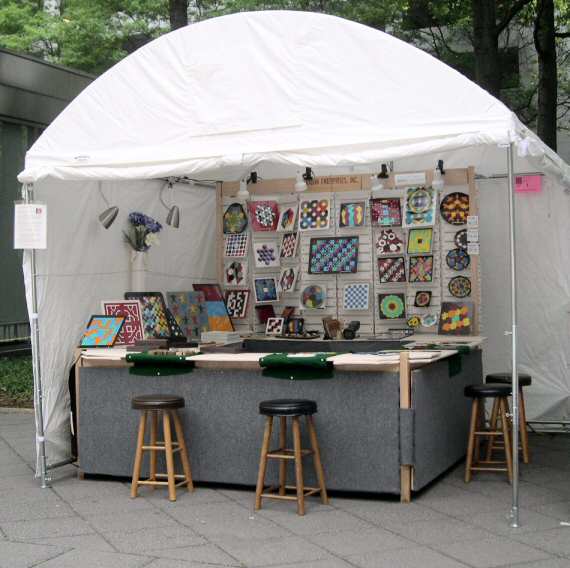
 |
The new tent, launched January 2008 |
|

After 18 years of traveling with the handsome all-wood booth with its own roof and awnings, Kate finally gave in and acquired a first-rate artist's tent to protect her display and reduce her workload. (Thanks, Howard Alan, for nagging me into it.) She researched available tents among fellow artists and online, then decided on a TrimLine canopy with steel pipes and a brilliantly designed structure whose designers were themselves artists and put into the design all their experience and ingenuity. They even have accessories to allow one person working alone to do the whole set-up. When the first rains came and Kate could just zip down the sides for instant protection, she wondered why she had ever struggled with loose curtains that had to be fastened with countless ropes. And on the very first evening, when she could just zip down all the curtains and walk away, instead of spending an hour stashing all displayed items under the counters, the booth had already earned back its investment. Opening in the morning by just rolling up two curtains was a dream compared to the old way. The old booth had been marvelous for display, assembly, sturdiness, compact packing. Kate thought long and hard, for nearly a year, how all its virtues could be captured in the new design. "You can't improve on perfection," she muttered frequently. The answer: build the interior display like the old one, only better. Brainstorming with her son, Eric Bare, a professional stage manager, brought it all into focus. Instead of soft table covers, use stylish, sturdy carpeted panels. Instead of loose covers, attach the vinyl permanently. Instead of numerous loose boards on the floor to keep the stock off the ground, use just 4 full-length elevated shelves. Aahh... And instead of the awkward long monotonous shelves, use new modern slat wall folding screens for a more sophisticated presentation, where angles create visual variety. Finally, to assure that the tent stays put in high winds, attach it to the wood structure whose aggregate weight approaches 1000 pounds. Results: Neither Florida's fickle weather nor Pittsburgh's treacherous storms managed to budge the tent more than 3 inches. The acid test was Chicago in July. It is the extreme... This show is staged on a beautiful plaza on Michigan Avenue alongside the river, midst highrises forming canyons channeling winds in all directions.Kudos and deep appreciation to the wizards who helped build this wondrous edifice in time for the Florida trip in January 2008:
|
|
| Back to Show Schedule |